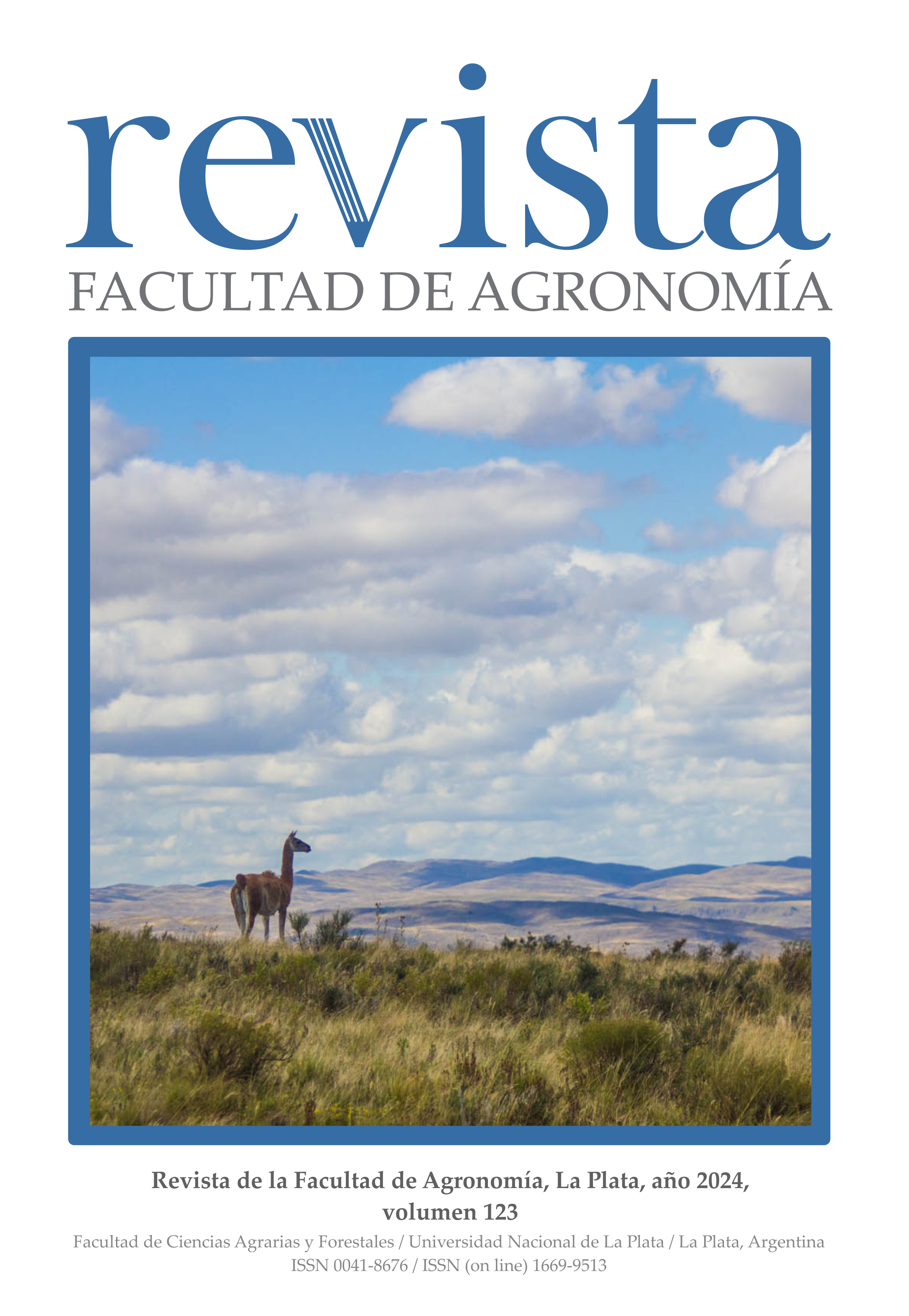Estimation of the crop coefficient Kc for winter crops and pastures in the upper basin of the Sauce Chico river of the Province of Buenos Aires from remote sensors
DOI:
https://doi.org/10.24215/16699513e136Keywords:
remote sensing, crop coefficient, normalized green evapotranspiration index, upper basin of the Sauce Chico river Buenos Aires ArgentinaAbstract
Obtaining precise evapotranspiration values is a complex task, however Geographic Information Technologies allow us to approximate some parameters for their precise estimation adjusted to local conditions. The objective of this work was to estimate the crop coefficient from the Normalized Difference Vegetation Index (NDVI) of the satellite images, for winter crops and pastures of the upper basin of the Sauce Chico river of the Province of Buenos Aires - Argentina, and compare them with the Kc of bibliography reference. Monthly NDVI values were used, from which plots with winter crops and meadows were identified; Then, through mathematical expressions, the NDVI was related to the Kc of crops and grasslands. Subsequently, the Kc obtained from remote sensors were compared with those published by Food and Agricultura Organization (FAO) and applied to the calculation of crop evapotranspiration. The results of this work approximate specific Kc values for the crop and zonal conditions, which allowed the estimation of the evapotranspiration of crops and pastures to be used at the basin level, and thus contribute to the study of regional hydrological dynamics.
Downloads
Metrics
References
Allen R., Pereira L., Raes D. y Smith M. (2006). Evapotranspiración del cultivo. Guía para la determinación de los requerimientos de agua de los cultivos. Estudio de Riego y Drenaje 56. Organización de las Naciones Unidas para la Agricultura y la Alimentación.
Bhatti, Saad Saleem y Nitin Kumar Tripathi. (2014). Built-up area extraction using Landsat 8 OLI imagery. GIScience & Remote Sensing, 51(4), 445-467. https://doi.org/10.1080/15481603.2014.939539
Burgos, J.J. (1963). Las heladas en la Argentina. Colección Científica, 3. INTA, Buenos Aires.
Castañeda-Ibáñez, C.R., Martínez-Menes, M., Pascual-Ramírez, F., Flores-Magdaleno, H., Fernández-Reynoso, D.S. y
Esparza-Govea, S. (2015). Estimación de coeficientes de cultivo mediante sensores remotos en el distrito de riego río Yaqui, Sonora, México. Agrociencia, 49(2), 221-232.
Cuesta, A., Montoro, A., Jochum, A. M., López, P. y Calera, A. (2005). Metodología operativa para la obtención del coeficiente de cultivo desde imágenes de satélite. ITEA Información Técnica Económica Agraria, 101 (3), 212-224.
Fang, Y., Sun, G., Caldwell, P., McNulty, S., Noormets, A., Domec, J.C., King, J., Zhang, Z., Zhang, X., Lin, G., Zhou, G., Xiao, J. y Chen, J. (2016). Monthly land cover‐specific evapotranspiration models derived from global eddy flux measurements and remote sensing data. Ecohydrology, 9 (2), 248-266. https://doi.org/10.1002/eco.1629
Frangi, J. y Bottino, O. (1995). Comunidades vegetales de Sierra de la Ventana, Provincia de Buenos Aires, Argentina. Revista de la Facultad de Agronomía, 71, 93-133.
Lizzi, J., Garbulsky, M., Golluscio, R. y Deregibus, A. (2007). Mapeo indirecto de la vegetación de Sierra de la Ventana, Provincia de Buenos Aires. Ecología Austral. Asociación Argentina de Ecología, 17, 217-230.
Marini, M. F. (2008). El avance de la frontera agrícola en el área adyacente al sistema Sierras de la Ventana (Buenos Aires, Argentina). Investigaciones Geográficas (España), 47, 111-121. https://doi.org/10.14198/INGEO2008.47.06
Pereyra, F. y Tobío, M. (2018). Geomorfología de la Provincia de Buenos Aires. Buenos Aires Argentina Dirección de Geología Ambiental y Aplicada. Servicio Geológico-Minero Argentino (SEGEMAR). Recuperado en diciembre de 2022 de https://repositorio.segemar.gob.ar
Sánchez, Tomás J., Caselles Miralles, V., Niclòs Corts, R., Valor Micó, E. y Coll Company, C. (2005). Cálculo de la evapotranspiración real diaria en la zona norte de Finlandia empleando técnicas de teledetección. GeoFocus, (5), 278-300.
SATVeg. (s.f.). “Sistema de Análise Temporal da Vegetação”, Recuperado en diciembre de 2022 de https://www.satveg.cnptia.embrapa.br
Segura-Castruita, M.A. y Ortiz-Solorio, C.A. (2017). Modelación de la evapotranspiración potencial mensual a partir de temperaturas máximas-mínimas y altitud. Tecnología y Ciencias del Agua, 8(3), 93-110. https://doi.org/10.24850/j-tyca-2017-03-06
Steduto, P., Hsiao, T., Fereres, E., y Raes, D. (2012). Respuesta del rendimiento de los cultivos al agua. Roma. Estudio FAO: Riego y Drenaje. Organización de las Naciones Unidas para la Agricultura y la Alimentación. Recuperado en diciembre de 2022 de https://www.fao.org
Zajac, C., Galantini, J., Zajac, E., Vallejos, A. y Córdoba, M. (2013). Análisis del rendimiento y el NDVI en cereales de invierno en el Sudoeste Bonaerense. Ciencia y experiencia para una siembra directa sustentable en los ambientes frágiles del S y SO Bonaerense. Galantini.
Downloads
Published
How to Cite
Issue
Section
License
Copyright (c) 2024 Esteban Sergio Manis, Raúl J. Rosa, Gerardo Andrés Denegri, Fernanda Julia Gaspari

This work is licensed under a Creative Commons Attribution-NonCommercial-ShareAlike 4.0 International License.
A partir de 2019 (Vol. 118 número 2) los artículos se publicarán en la revista bajo una licencia Creative Commons Atribución- NoComercial-CompartirIgual 4.0 Internacional (CC BY-NC-SA 4.0)
Acorde a estos términos, el material se puede compartir (copiar y redistribuir en cualquier medio o formato) y adaptar (remezclar, transformar y crear a partir del material otra obra), siempre que a) se cite la autoría y la fuente original de su publicación (revista y URL de la obra), b) no se use para fines comerciales y c) se mantengan los mismos términos de la licencia.
Previo a esta fecha los artículos se publicaron en la revista bajo una licencia Creative Commons Atribución (CC BY)
En ambos casos, la aceptación de los originales por parte de la revista implica la cesión no exclusiva de los derechos patrimoniales de los/as autores/as en favor del editor, quien permite la reutilización, luego de su edición (posprint), bajo la licencia que corresponda según la edición.
Tal cesión supone, por un lado, que luego de su edición (posprint) en Revista de la Facultad de Agronomía las/os autoras/es pueden publicar su trabajo en cualquier idioma, medio y formato (en tales casos, se solicita que se consigne que el material fue publicado originalmente en esta revista); por otro, la autorización de los/as autores/as para que el trabajo sea cosechado por SEDICI, el repositorio institucional de la Universidad Nacional de La Plata, y sea difundido en las bases de datos que el equipo editorial considere adecuadas para incrementar la visibilidad de la publicación y de sus autores/as.
Asimismo, la revista incentiva a las/os autoras/es para que luego de su publicación en Revista de la Facultad de Agronomía depositen sus producciones en otros repositorios institucionales y temáticos, bajo el principio de que ofrecer a la sociedad la producción científica y académica sin restricciones contribuye a un mayor intercambio del conocimiento global.































